AI in 2024: Beyond Boundaries - The Next Leap in Cyber-security and Innovation
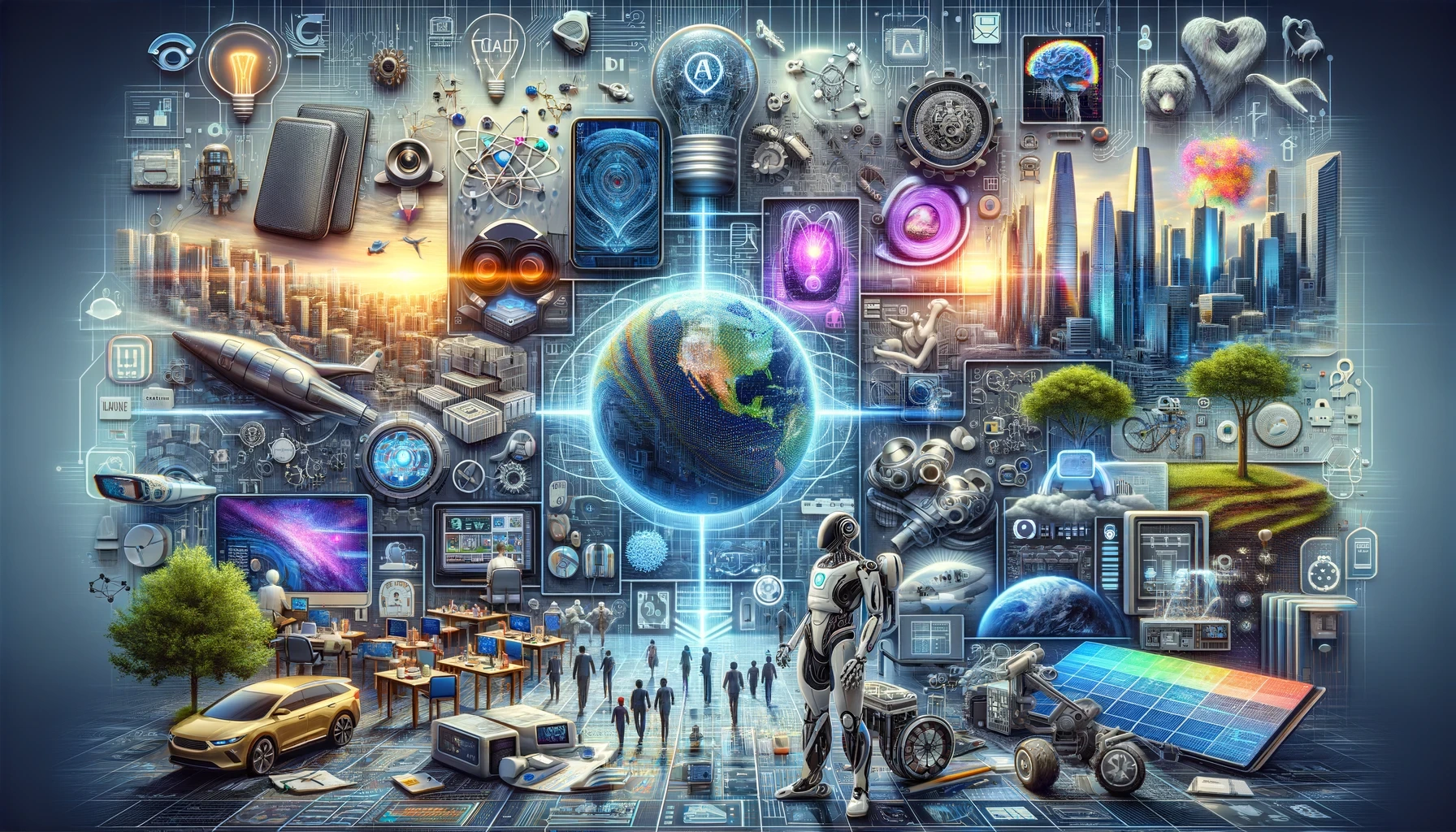
At the start of 2024, we reflect on the transformative journey of AI in the past year. The AI landscape has evolved rapidly, bringing innovations once considered science fiction into reality. For ProCheckUp a leader in cyber-security, adapting to these changes is crucial for staying ahead in a tech-driven future. This blog aims to dissect the anticipated AI breakthroughs of 2024, focusing on their impact across various sectors, with a special emphasis on cyber-security implications.
AI Innovations for 2024:
LLM-Based Operating Systems with Advanced Chipsets:
2024 is witnessing the rise of operating systems powered by Large Language Models (LLMs), utilising the latest AI-enabled chipsets from Intel and AMD. These currently rumored systems promise a revolution in computing, offering intuitive interfaces and smarter resource allocation. A notable example is "The Rabbit R1," a pocket-sized AI device that redefines user interaction with technology. Unlike traditional app-driven devices, The Rabbit R1 relies on its AI model "LAMB" which is Large Action Model based to understand and execute user instructions, signifying a shift towards more natural and intuitive user experiences.
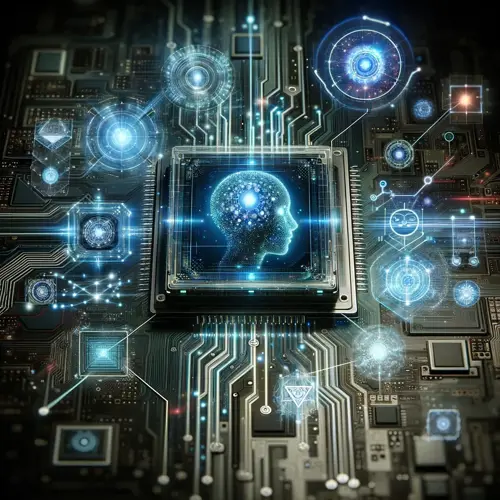
The AI-Powered Smartphone Revolution - Samsung S24 Ultra:
The collaboration between Google and Samsung is redefining the smartphone experience with the Samsung S24 Ultra. This device's AI-driven features, such as enhanced photography and real-time language translation, are reshaping smartphone technology. The influence of AI-centric devices like The Rabbit R1 is evident, as they prioritize AI-driven interaction over traditional app-based interfaces, posing new security challenges. Related article: "The Top 10 LLM Security Vulnerabilities"

Meta's AI Prowess with LLama 3 LLM and Mistral AI Excellence with Mistral 2.0:
Meta's advancements with LLama 3 LLM and Mistral AI Mistral 2.0 are expected to push the boundaries of virtual and augmented reality, changing how we interact with virtual spaces and introducing new cyber-security challenges.
The Rise of 'Mixture of Experts' Models:
The 'mixture of experts' approach in AI is gaining momentum, promising faster and more efficient AI responses. This approach is particularly relevant in real-time applications and has significant implications for cyber-security, especially in threat detection and response.
Tailored AI for Specific Industries:
AI models customized for industries like healthcare and insurance are becoming more prevalent. These specialised models are enhancing efficiency and accuracy in these sectors, raising important data security and privacy considerations.
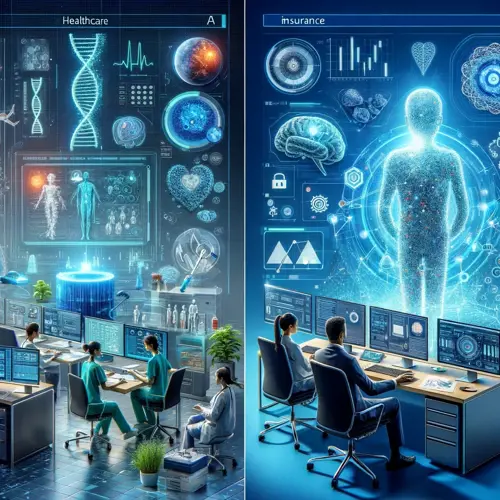
Multimodal AI Models - A Holistic Approach:
The advancement in multimodal AI models capable of processing diverse data types is creating more sophisticated AI applications. This development adds complexities to the cyber-security landscape, requiring robust security measures.

Large Action Models (LAMs): Revolutionizing AI's Role in the Real World
LAMs expand upon the capabilities of LLMs by transforming them into 'agents' capable of autonomously executing tasks. Unlike LLMs, which primarily generate text, LAMs can understand and achieve complex goals, combining the language proficiency of LLMs with the ability to make decisions and perform actions autonomously.
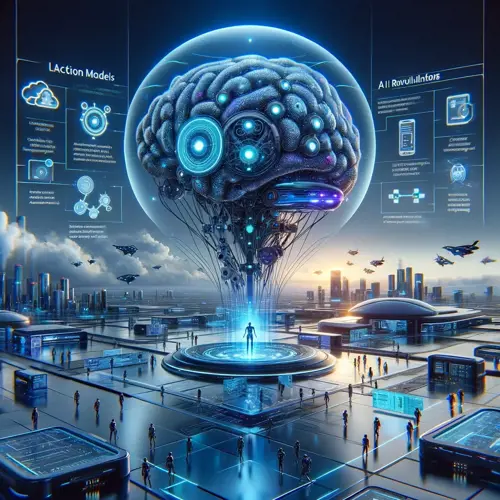
Structure: The structure of LAMs is tailored to mimic the composition of various applications and human actions, enabled by advancements in neuro-symbolic programming. This allows LAMs to interact with and replicate human actions across different technology interfaces without relying solely on textual input.
Capabilities: LAMs are designed to understand complex human goals expressed in natural language, translate these into actionable steps, and interact intelligently with the world. This includes adapting to changing circumstances, collaborating with other LAMs, and integrating with external systems like IoT devices.
Legal Battles and AI:
As AI becomes more prevalent, more legal disputes are expected to arise, particularly around data breaches, misuse of AI, and intellectual property rights. Companies will need to navigate complex legal landscapes, ensuring compliance with evolving AI laws and regulations.

Database Access and Privacy:
With AI's reliance on large datasets, issues around database access and privacy are critical. Companies must balance the need for data to train AI models with privacy concerns, adhering to regulations like GDPR and CCPA.

Ensuring Ethical AI Use:
Ethical AI use involves addressing biases in AI algorithms, ensuring transparency in AI decision-making, and maintaining user trust. Companies must establish ethical guidelines and practices for AI use, including regular audits and ethical training for AI teams.
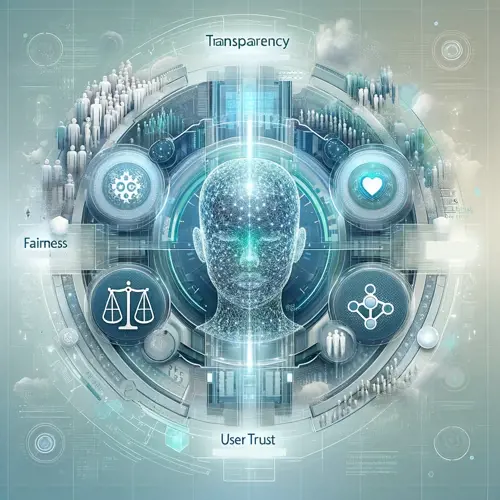
Quantisation and AI Efficiency:
Democratizing AI Through Quantisation: Quantisation reduces the computational resources needed for AI, making AI technologies more accessible to smaller businesses and individuals. This democratization of AI is enabling a wider range of applications and innovation.

Cyber-security in Lightweight AI Applications: As AI applications become more lightweight and widespread on workstations, laptops, phones, ensuring their cyber-security is paramount. This includes protecting against data breaches and ensuring the integrity of AI algorithms.
Expanding AI's Understanding - Larger Window Sizes:
Enhanced AI Capabilities: Larger window sizes in AI models allow for processing more complex and contextual information, leading to more sophisticated and accurate AI applications in areas like natural language processing and predictive analytics.
Security Considerations for Larger Data Sets: Processing larger data sets raises significant cyber-security concerns. Companies must implement advanced security protocols to protect against data leaks and unauthorized access.

Google's Gemini Ultra - A New AI Milestone:
Speculating on Gemini Ultra's Capabilities: While details are scarce, Gemini Ultra is expected to represent a significant advancement in AI, potentially in areas like machine learning efficiency, data processing speed, and algorithmic complexity.
Impact on Cyber-security: Any advancement in AI capabilities also advances potential cyber-security threats. Gemini Ultra's introduction will likely necessitate enhanced cybersecurity measures to protect against more sophisticated AI-driven attacks.

The Emergence of Advanced AI Robots:
Roles of Advanced AI Robots: Advanced robots, like the successors to Optimus, are expected to take on more complex tasks in industries such as manufacturing, logistics, and even healthcare, potentially transforming these sectors.
Cybersecurity Risks: The integration of advanced robots in various industries introduces new cybersecurity risks, including the potential for hacking and misuse. Ensuring the security of these robots is crucial to prevent them from becoming liabilities.
The Evolution of AI in User Experience:
AI-Driven Personalisation: Devices like the Samsung S24 Ultra are leveraging AI for personalized user experiences, from customized content to intuitive user interfaces.
Protecting Personal Data: With increased personalisation comes the risk of sophisticated cyber attacks aimed at personal data. Robust security measures, including advanced encryption and user authentication, are essential.
AI's Role in Environmental Sustainability:
AI in Climate Change and Environmental Efforts: AI is being used to model climate change impacts, optimize renewable energy usage, and monitor environmental changes. These applications can play a crucial role in sustainability efforts.

Securing Environmental AI Systems: Protecting these AI systems against tampering and misinformation is vital to ensure they serve their intended purpose and provide accurate information.
Quantum Computing and AI:
Enhancing AI with Quantum Computing: Quantum computing offers the potential to exponentially increase AI's data processing capabilities, opening new frontiers in AI applications.
Cyber-security Implications: The combination of AI and quantum computing introduces complex cyber-security challenges. Protecting quantum-enhanced AI systems from emerging threats will require new approaches to cyber-security.

Cyber Security and AI:
The integration of AI in cyber-security is transforming how organizations defend against and respond to cyber threats. The emergence of sophisticated AI-driven threats like small LLM worms and trained 7B worms will challenge traditional cyber-security paradigms, requiring more advanced and dynamic defense strategies. The use of LLMs in security testing is a significant step forward, enabling organizations to prepare for a wide range of attack scenarios. As we start 2024, the focus for cyber-security professionals is clear: embrace AI-driven solutions, foster collaboration, and maintain a commitment to ethical practices in the face of rapidly evolving cyber threats.
Emerging Threats: Small LLM Worms and Trained 7B Worms:

- Nature of the New Threats: The cyber-security landscape in 2024 will increasingly encounter sophisticated threats like small Quantised LLM (Large Language Model) worms and trained 7B worms. With memory requirements of about 6GB, and the ability to run on mid range and above processors they can spread to increasingly low end hardware. These AI-driven threats are more advanced than traditional malware, capable of evolving and adapting to bypass security measures.
- Small Quantised LLM Worms: These worms use advanced natural language processing capabilities to mimic legitimate communication, making them harder to detect. They can modify their behavior based on the environment, making standard detection methods less effective.
- Trained Quantised 7B Worms: These are AI-driven worms trained on massive datasets of security exploits and evasion techniques (7 billion parameters or more), giving them unprecedented capabilities in terms of evasion, payload delivery, and spreading mechanisms.
- Impact on Cyber-security Strategies: The emergence of these AI-driven threats requires a paradigm shift in cyber-security strategies. Traditional defense mechanisms, which often rely on recognising known patterns, are less effective against these adaptive threats. This necessitates the development of more dynamic, AI-driven defense systems that can anticipate and respond to evolving threats.
LLM-Based Security Testing:

- Advancements in Security Testing: The use of Large Language Models for security testing marks a significant advancement in the field. LLMs can simulate a wide range of cyberattacks, from phishing to advanced persistent threats, providing a comprehensive testing environment.
- Simulating Sophisticated Attacks: LLM-based systems can create realistic attack scenarios that mimic the tactics, techniques, and procedures (TTPs) of modern cyber adversaries. This allows organizations to test their defenses against a broader range of threats, including those that have not been seen before.
- Improving Defense Mechanisms: By using LLMs in security testing, organizations can identify vulnerabilities in their systems more effectively. This leads to the development of more robust defense mechanisms, as security teams can train against a wider array of attack scenarios.
- Training and Awareness: LLM-based security testing can also be used for training cyber-security personnel. By simulating real-world attack scenarios, it helps in honing the skills of security teams and improving their readiness to respond to actual incidents.
Implications for Future Cyber-security Strategies:
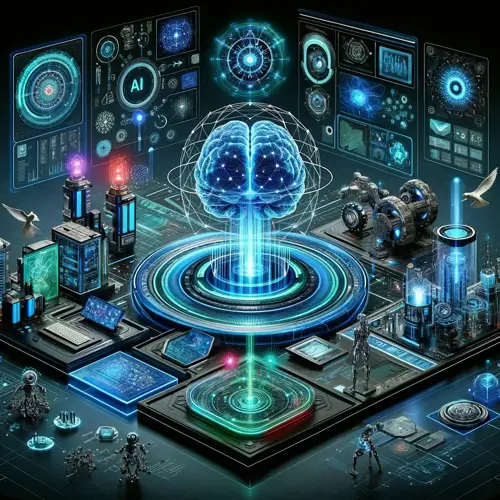
- Need for AI-Driven Security Solutions: The rise of AI-driven threats necessitates the adoption of AI-driven security solutions. Organizations will need to invest in AI technologies that can detect and respond to threats in real-time.
- Continuous Monitoring and Adaptation: Cyber-security in 2024 is about continuous monitoring and adaptation. AI systems enable real-time analysis of threats and automatic adaptation of defense mechanisms.
- Collaboration and Information Sharing: The complexity of AI-driven threats requires greater collaboration and information sharing among organizations, cyber-security vendors, and government agencies. Sharing insights about emerging threats and defense strategies will be key to staying ahead of adversaries.
- Ethical Considerations in AI-Driven Cyber-security: As AI plays a larger role in cyber-security, ethical considerations, particularly around privacy and data use, become increasingly important. Organizations must ensure that their use of AI in cyber-security aligns with legal and ethical standards.
Industry-Specific Implications:
As AI becomes more tailored to specific industries, the cyber-security implications become more nuanced. In healthcare, for instance, AI's ability to process sensitive patient data raises significant privacy concerns. Similarly, in the insurance sector, AI's role in risk assessment must be balanced with data protection. This section will explore how industry-specific AI models can be secured against data breaches and misuse.
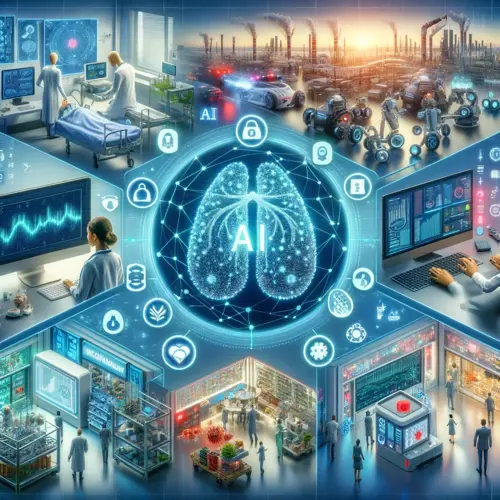
AI in Healthcare and Life Sciences:
In 2024, the healthcare and life sciences sectors are witnessing a trans-formative impact thanks to AI. This year is expected to bring significant strides in how AI is being utilised, bringing forth innovations that are not only groundbreaking but also crucial in addressing some of the most pressing healthcare challenges.
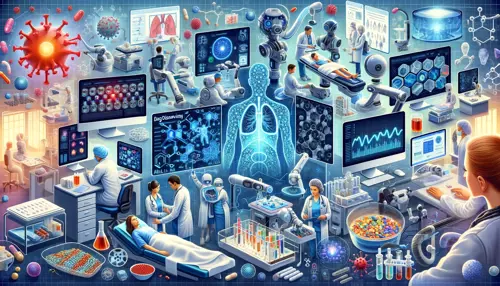
Collaboration Between AI and Healthcare Professionals:
The future of healthcare sees a collaborative relationship between AI technologies and healthcare professionals. AI is not replacing doctors and medical staff but rather augmenting their capabilities, providing them with tools and insights to make better-informed decisions and offer more effective patient care.

AI-Driven Diagnostics and Personalized Medicine:
AI technologies are revolutionizing diagnostics by providing faster, more accurate analyses of medical imaging, genetic information, and patient data. This has led to more personalized medicine approaches, where treatments are tailored to individual patient profiles. The integration of AI in diagnostics is not just enhancing the accuracy but also significantly reducing the time required for diagnosis, which is critical in conditions where early detection can drastically improve patient outcomes.

AI in Drug Discovery and Development:
The drug discovery process, traditionally a time-consuming and costly endeavor, is being expedited by AI. AI algorithms are capable of analyzing vast datasets to identify potential drug candidates, predict their efficacy, and even anticipate side effects. This is not only speeding up the process of bringing new drugs to market but also making it more cost-effective, which could have a profound impact on global health.

Wearable AI Techno
Wearable AI technologies are becoming more prevalent and sophisticated. These devices continuously monitor health indicators such as heart rate, blood pressure, and glucose levels, providing real-time data that can be used for proactive health management. This constant monitoring is particularly beneficial for patients with chronic conditions, allowing for timely interventions and adjustments in treatment.

AI in Genomics and Precision Medicine:
AI's role in genomics is expanding, enabling more precise and comprehensive analysis of genetic data. This is paving the way for precision medicine, where treatments and preventive measures are highly personalized based on an individual's genetic makeup. AI-driven genomics is a game-changer in understanding the genetic basis of diseases and developing targeted therapies.

Ethical Considerations and Regulatory Compliance:
The use of AI in healthcare also raises significant ethical considerations and regulatory compliance issues. Ensuring patient privacy, addressing potential biases in AI algorithms, and complying with regulations like GDPR and HIPAA are critical challenges that need to be addressed as AI becomes more ingrained in healthcare.

Cyber-security Challenges in Healthcare AI:
With the increasing use of AI in healthcare, cyber-security becomes a paramount concern. Protecting sensitive patient data against breaches and ensuring the integrity of AI-driven medical devices and applications is crucial. The healthcare sector must implement robust cyber-security measures to safeguard against data theft, ransomware attacks, and other cyber threats.

AI in Financial Services:
In 2024, the financial services sector is expected to experience a significant transformation driven by AI. We will explore various facets of AI's impact on financial services, highlighting both the opportunities and challenges it presents, especially from a cyber-security perspective.
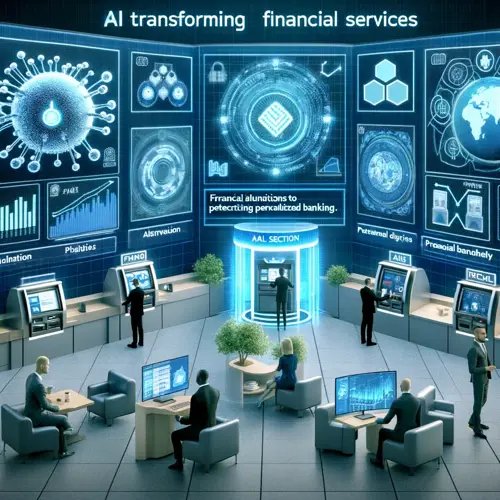
AI in Fraud Detection and Prevention:
One of the most critical applications of AI in financial services is in fraud detection. AI systems are capable of analyzing patterns in large datasets to identify and prevent fraudulent activities. In 2024, these systems have become more sophisticated, using machine learning algorithms to detect anomalies in real-time, significantly reducing the incidence of fraud. The cyber-security aspect is crucial here, as protecting financial data from cyber threats is paramount.
Automated Trading and Investment Strategies:
AI is revolutionizing the way trading and investment decisions are made. Automated trading systems powered by AI algorithms can analyze market data, predict market trends, and execute trades at a speed and accuracy that is unattainable by human traders. While this brings efficiency to the market, it also introduces new cyber-security risks, such as the potential for AI-driven market manipulation.
Personalized Banking Services:
AI is enabling more personalized banking experiences for customers. From personalized investment advice to customized financial products, AI is helping financial institutions offer services tailored to individual customer needs. This personalisation, however, raises data privacy concerns, necessitating robust cyber-security measures to protect customer information.
AI in Risk Assessment and Management:
Financial institutions are using AI to improve their risk assessment and management processes. AI algorithms can analyze vast amounts of data to identify potential risks, assess loan eligibility, and predict defaults. This not only improves the accuracy of risk assessments but also helps in developing better risk mitigation strategies.
Regulatory Compliance and AI:
With the increasing use of AI in financial services, regulatory compliance has become more complex. AI systems must comply with financial regulations, including those related to anti-money laundering (AML) and know your customer (KYC) requirements. Ensuring that AI systems adhere to these regulations is a significant challenge for financial institutions.
Challenges in AI Implementation:
Implementing AI in financial services is not without its challenges. These include integrating AI with existing systems, ensuring the accuracy and fairness of AI algorithms, and addressing the cyber-security risks associated with AI-driven financial services.
The Future of AI in Financial Services:
Looking ahead, AI is set to continue its transformative impact on financial services. The sector is likely to see more innovative applications of AI, further enhancing efficiency, customer experience, and financial security. However, staying vigilant against cyber-security threats and ensuring ethical use of AI will be critical for the sustainable growth of AI in this sector.
AI in Education and Training:
In 2024, AI's role in education and training is expected to be more pronounced than ever, revolutionizing how we learn and teach. This section will explore the various dimensions of AI's impact on education and training, highlighting both the opportunities and challenges it presents.
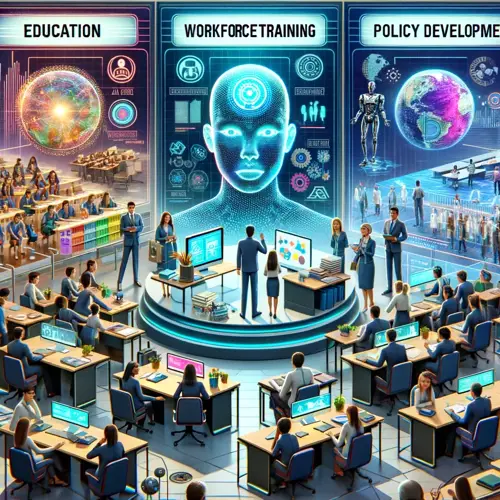
Personalized Learning Experiences:
Adaptive Learning Platforms: AI-powered platforms are providing personalized learning experiences by adapting content to each student's learning pace, style, and preferences. These platforms can identify areas where students struggle and adjust the curriculum accordingly.

Customised Educational Pathways: AI is enabling the creation of customized educational pathways for students, helping them focus on their strengths and interests, which is particularly beneficial in higher education and vocational training.
AI in Classroom Teaching:
Assisting Teachers: AI tools are assisting teachers in grading, providing insights into student performance, and identifying areas where students need more support. This allows teachers to focus more on teaching and less on administrative tasks.
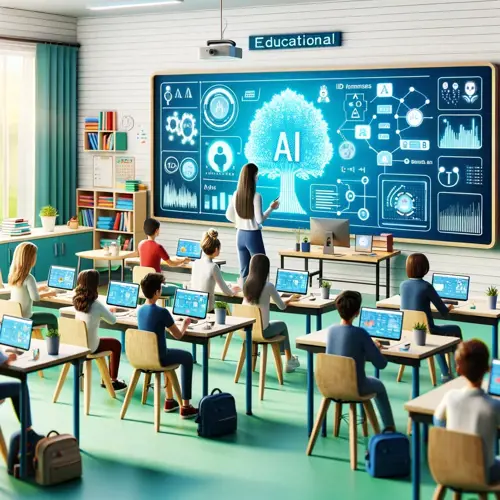
Enhanced Engagement: AI-driven tools and interactive learning environments are making learning more engaging and interactive, which is especially effective in subjects that benefit from visual and experiential learning.
AI-Driven Educational Content Creation:
Automated Content Generation: AI is being used to generate educational content, including customized textbooks, study guides, and interactive learning materials. This not only saves time but also ensures that the content is up-to-date and relevant.

Language Translation and Accessibility: AI-driven language translation tools are making educational content accessible to a wider audience, breaking language barriers in education.
AI in Skills Training and Professional Development:
- Workforce Training: In the corporate world, AI is revolutionizing workforce training by providing employees with personalized learning experiences and helping them develop the skills needed in an ever-evolving job market.
- Continuous Learning: AI enables continuous learning and upskilling, which is essential in today's fast-paced work environment, where staying updated with the latest skills and knowledge is crucial.
Challenges and Ethical Considerations:
Data Privacy and Security: With AI systems processing students' personal data, ensuring data privacy and security is a major concern. Educational institutions must implement stringent cyber-security measures to protect this data.
Bias and Fairness: There is a risk of bias in AI-driven educational tools, which can affect the quality and fairness of education. Ensuring that AI systems are unbiased and equitable is essential.

The Future of AI in Education:
Expanding Access to Education: AI has the potential to expand access to quality education, especially in underprivileged and remote areas.
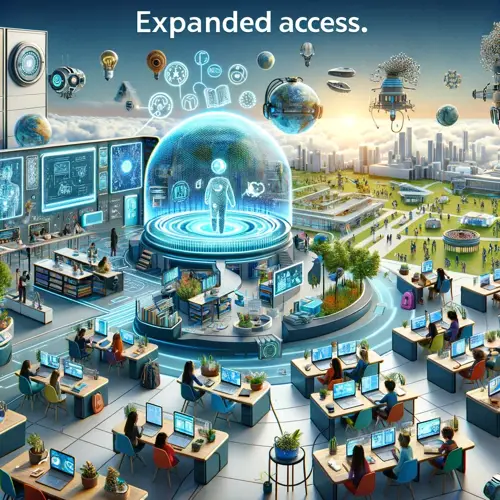
Lifelong Learning: AI is facilitating lifelong learning, allowing individuals to continuously acquire new skills and knowledge throughout their lives.
Innovative Educational Models: AI is enabling the development of innovative educational models, such as flipped classrooms and project-based learning, which could redefine traditional education systems.
AI and the Future of Work:
As AI reshapes the future of work in 2024, it's clear that while some jobs are at risk of automation, others are evolving to incorporate AI as a tool. The key for professionals in these fields is to adapt by developing skills that complement AI, focusing on areas where human expertise and creativity are irreplaceable. For businesses and educational institutions, the challenge lies in preparing the workforce for this new landscape, emphasizing skills development, and continuous learning.
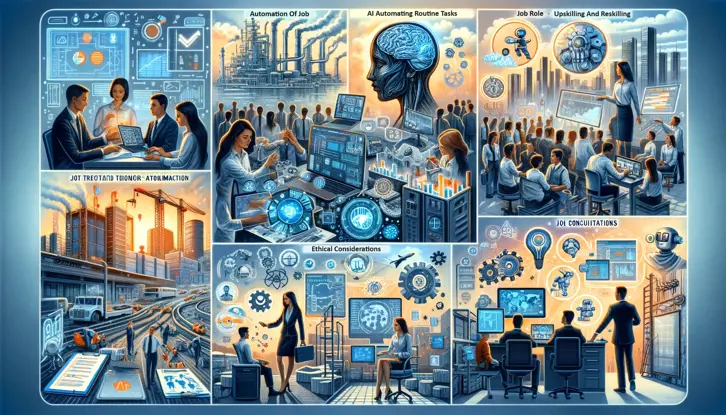
Automation and Job Transformation:
Automating Routine Tasks: AI is automating routine and repetitive tasks across various industries, leading to a transformation in job roles. While some jobs are being phased out, AI is also creating new opportunities in areas that require complex decision-making and creative thinking.
Job Role Evolution: The nature of many jobs is evolving due to AI integration. Roles are shifting from manual and task-oriented to more strategic and analytical, requiring a different set of skills.
AI-Driven Workforce Efficiency:
Enhanced Productivity: AI tools are enhancing workforce productivity by optimizing workflows, managing schedules, and providing insightful data analysis. This allows employees to focus on more value-added tasks.
Decision Support Systems: AI-driven decision support systems are aiding employees in making more informed and effective decisions by providing predictive analytics and data-driven insights.

Skills and Training for an AI-Driven Workplace:
Upskilling and Reskilling: As AI changes the nature of work, there is a growing need for upskilling and reskilling. Employees need to adapt by acquiring new skills, such as data literacy, AI management, and digital collaboration.
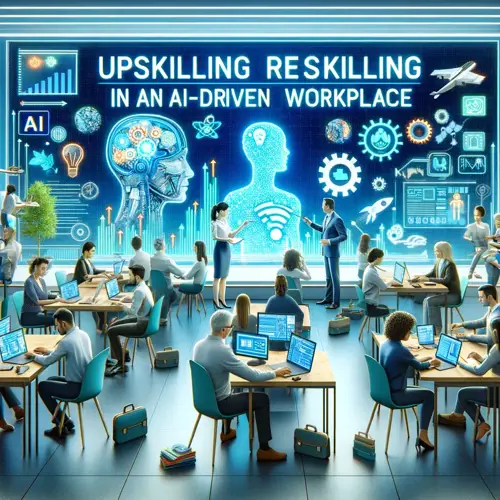 Continuous Learning Culture: Organizations are fostering a culture of continuous learning, where employees are encouraged to continually update their skills to stay relevant in an AI-driven work environment.
Continuous Learning Culture: Organizations are fostering a culture of continuous learning, where employees are encouraged to continually update their skills to stay relevant in an AI-driven work environment.
AI in Human Resources and Talent Management:
AI in Recruitment: AI is streamlining the recruitment process by automating candidate screening and using predictive analytics to identify the best candidates.
Employee Engagement and Retention: AI tools are being used to enhance employee engagement and retention, analyzing employee feedback and behavior to identify trends and improve the workplace environment.
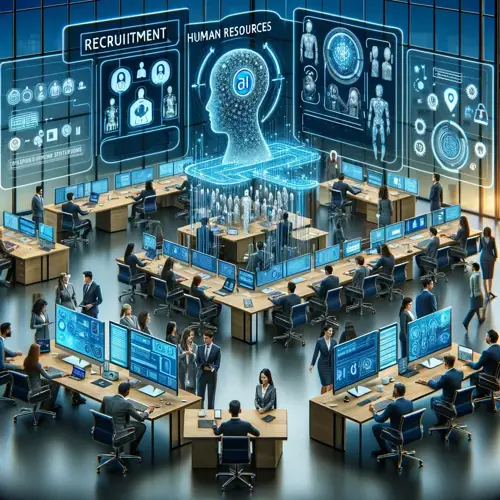
Remote Work and AI:
Facilitating Remote Work: AI is playing a crucial role in facilitating remote work. From virtual assistants to AI-driven project management tools, AI is enabling a more efficient and connected remote workforce.
Cyber-security in Remote Work: With the increase in remote work, cyber-security has become a critical concern. AI is being used to secure remote work environments, detect threats, and ensure data privacy.
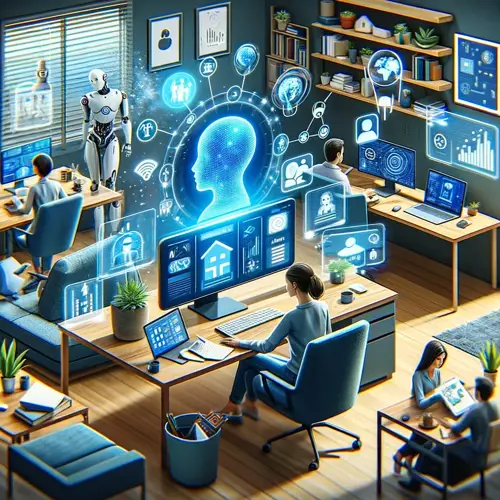
Ethical Considerations and Workplace Equity:
Bias in AI Tools: There is a risk of bias in AI tools used in the workplace, which can affect hiring, promotions, and employee evaluations. Ensuring that AI systems are fair and unbiased is essential.
Employee Privacy: Balancing the use of AI in monitoring and enhancing productivity with respect for employee privacy is a key challenge for organizations.
The Future Workplace Landscape with AI:
Hybrid Work Models: AI is enabling the development of hybrid work models, combining remote and in-office work, which are becoming increasingly popular.
Innovative Collaboration Tools: AI is driving the development of innovative collaboration tools that mimic in-person interactions, making remote and hybrid work more effective.
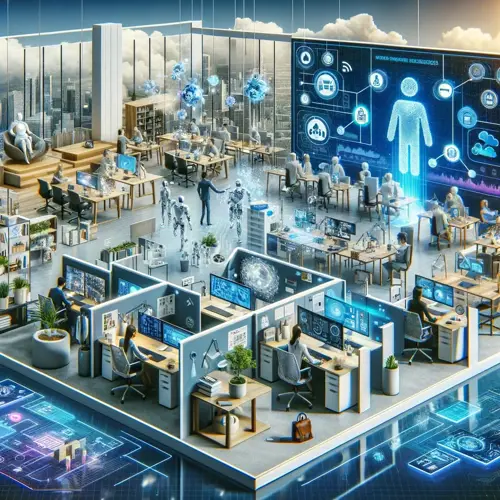
Jobs At Risk in 2024 from AI:
The future of work is being shaped by AI. We will explore how AI is changing the nature of work, the jobs that are at risk, and how businesses and individuals can prepare for an AI-assisted work environment.
Graphic Designers:
AI tools are now capable of performing tasks like basic design, layout, and even some creative work. While this can enhance the productivity of graphic designers, it also poses a risk to entry-level positions in the field.
The future for graphic designers will likely involve a blend of AI tools and human creativity, with a greater emphasis on innovative and complex design work that AI cannot easily replicate.

Market Research Analysts:
AI's ability to analyze large datasets and consumer trends is automating many aspects of market research. Analysts may find certain tasks, such as data collection and preliminary analysis, being taken over by AI.
However, the interpretation of data and strategic planning will still require the human touch, suggesting a shift in the role of market research analysts towards more strategic and advisory functions.
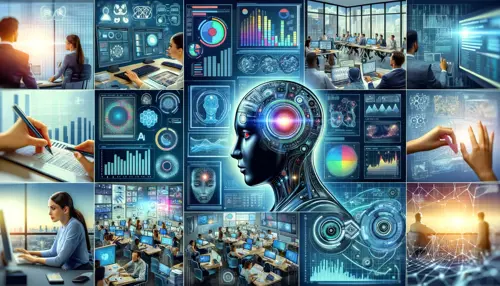
Tech Jobs (Coders, Computer Programmers, Software Engineers, Data Analysts):
AI is automating some aspects of coding and programming, particularly routine and repetitive tasks. This could reduce the demand for entry-level programming jobs.
However, the design, supervision, and maintenance of AI systems, as well as complex software development, will still require skilled professionals, indicating a shift towards more advanced and specialized roles in tech.
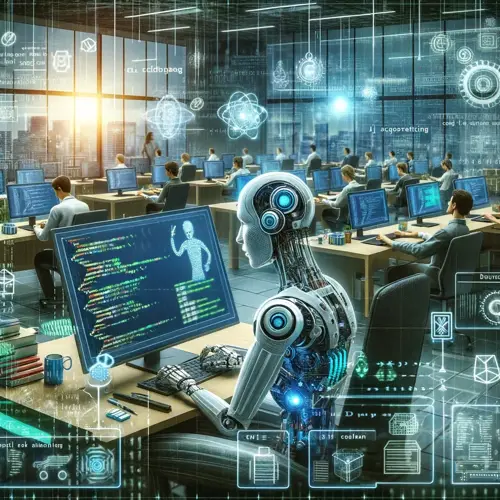
Media Jobs (Advertising, Content Creation, Technical Writing, Journalism):
AI-generated content is becoming more sophisticated, capable of producing basic news articles, content, and even advertising copy. This poses a risk to certain content creation and journalism jobs.
The future of these roles may involve more editorial, analytical, and creative tasks that require a deep understanding of context, culture, and human emotions, areas where AI still lags behind.
Legal Industry Jobs (Paralegals, Legal Assistants):
AI is being used for document review, legal research, and even some aspects of case preparation, tasks traditionally performed by paralegals and legal assistants.
The legal profession will likely see a shift where AI handles routine tasks, while human legal professionals focus on complex legal strategy, client relations, and courtroom practice.
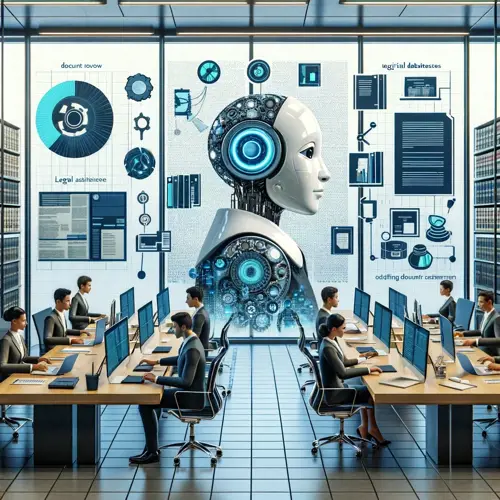
Teachers:
AI educational tools are supplementing teaching by providing personalized learning experiences and administrative support. However, they are not expected to replace teachers, as the human element is crucial in education.
Teachers' roles may evolve to focus more on mentorship, guidance, and facilitating learning experiences that AI cannot provide.
Finance Jobs (Financial Analysts, Personal Financial Advisors):
AI is automating many aspects of financial analysis and advice, particularly those involving data processing and routine analysis.
Financial professionals may need to focus more on relationship management, complex problem-solving, and strategic advising, areas where AI cannot fully replicate human abilities.
Traders:
Automated trading systems are increasingly common, and AI is capable of executing trades based on algorithmic strategies. This could reduce the need for human traders in certain contexts.
However, human insight, especially in volatile markets and for complex trading strategies, remains valuable.

AI Ethics and Public Policy:
The AI ethics and public policy landscape in 2024 is being shaped by thoughtful and proactive approaches in the UK and USA made in 2023. The UK's principles-based, pro-innovation approach and the USA's state-level legislative efforts reflect a nuanced understanding of the challenges and opportunities presented by AI. As AI continues to evolve, ongoing assessment, international collaboration, and stakeholder engagement will be key to developing effective and balanced AI policies.
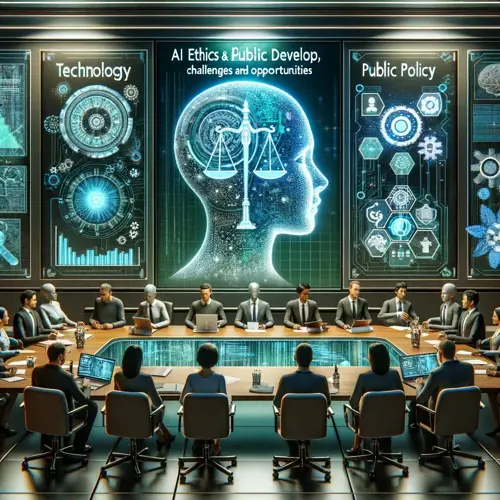
UK AI Regulations 2023:
Pro-Innovation Approach: The UK's policy paper on “A pro-innovation approach to AI regulation,” published in Spring 2023, emphasizes a balanced approach to AI regulation, focusing on innovation while ensuring safety, security, and robustness.
- Five Cross-Cutting Principles: The UK Government has outlined five principles for AI regulation: safety, security, and robustness; transparency and explainability; fairness; accountability and governance; and contestability and redress. These principles aim to ensure that AI systems are reliable, understandable, fair, accountable, and offer avenues for redress if harm occurs.
- Regulatory Sandbox: The establishment of a regulatory sandbox for AI is a significant step, allowing innovators to test new AI technologies under regulatory supervision. This sandbox will also aid the government in refining the interaction between regulation and emerging technologies.
- International Engagement: The UK's commitment to international engagement, including hosting an AI summit, highlights the importance of global coordination in AI regulation.
AI Legislation in the USA (2023):
- State-Level AI Legislation: In 2023, numerous states introduced AI-related bills, with several states enacting legislation or adopting resolutions. These legislative efforts address various aspects of AI, from inventory and assessment of AI systems in state agencies to the establishment of AI advisory councils.
- Focus on Standards and Trustworthy AI: The U.S. National Institute of Standards and Technology's efforts to develop federal standards for reliable, robust, and trustworthy AI systems reflect a growing concern about the potential misuse or unintended consequences of AI.
- Diverse Applications and Concerns: AI's application in areas like healthcare, self-driving cars, and digital assistants, coupled with concerns about misuse, is driving legislative efforts to study AI's impact and develop appropriate policy responses.
Challenges in AI Policy Development:
- Balancing Innovation and Regulation: Both the UK and USA are grappling with the challenge of balancing the need for innovation in AI with the need for regulation to ensure safety, security, and ethical use.
- Interoperability and Global Coordination: The UK's focus on interoperability with international regulatory frameworks and the USA's state-level legislative diversity highlight the complexity of achieving coordinated AI regulation.
Future Directions in AI Ethics and Policy:
- Continuous Monitoring and Evaluation: The UK's plan to establish a ‘central function’ for real-time assessment of the regulatory framework and the USA's state-level studies on AI's impact indicate a move towards continuous monitoring and evaluation of AI policies.
- Engagement with Stakeholders: Both countries emphasise the importance of engaging with various stakeholders, including businesses, experts, and the public, in AI policy development.
Conclusion:
As we start 2024, it's clear that AI is not just transforming technology; it's reshaping our entire world. From the way we interact with devices to how we approach complex global challenges, AI is at the forefront.
However, with these advancements come new responsibilities, especially in the realm of cyber-security. As a leading cyber-security firm, ProCheckUp are committed to staying ahead of these developments, ensuring that AI's potential is harnessed safely and ethically.



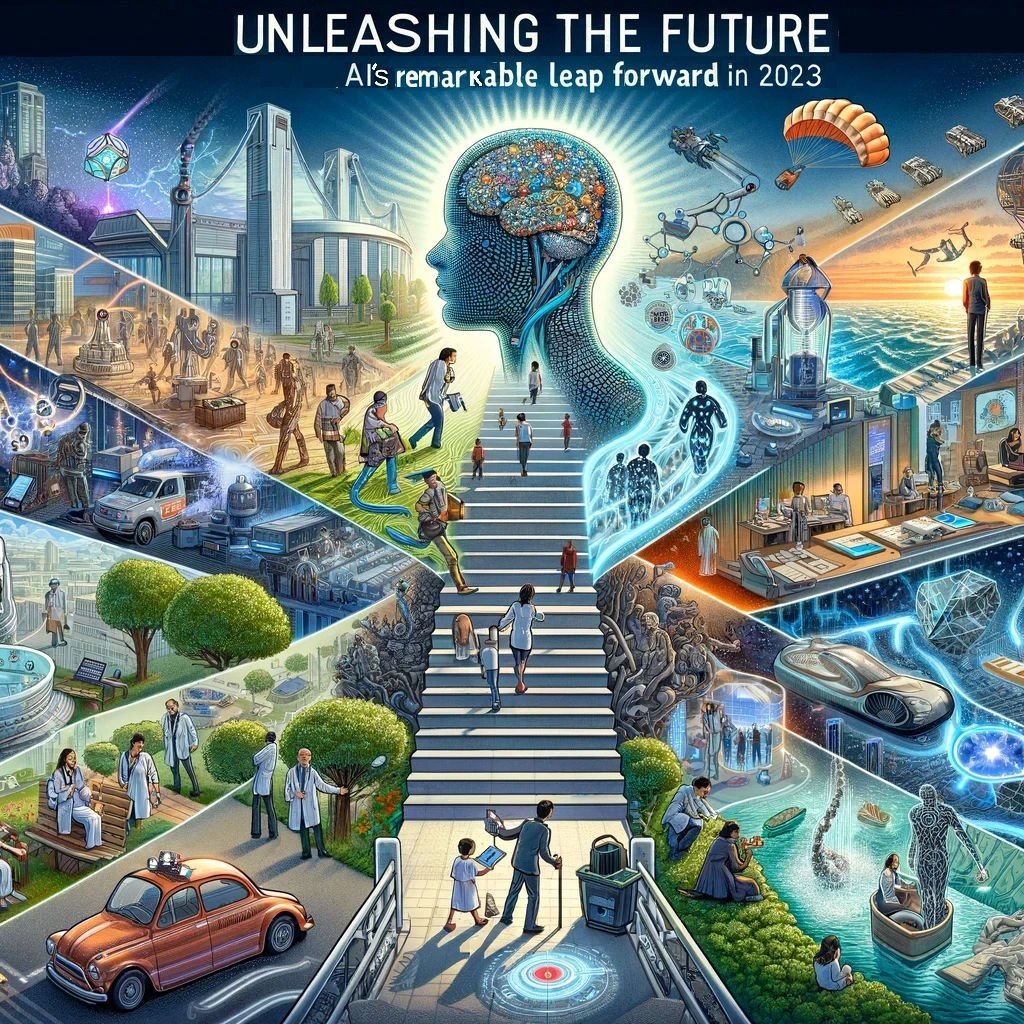
Categories